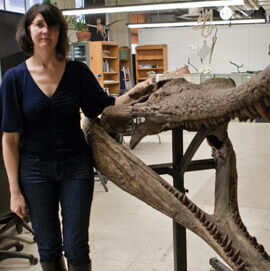
Fueled by Fossils

by Brandi Kulakowski (Dual MA 2012)
Carol Abraczinskas (BFA 1989) never knows what will cross her desk. One day it might be a tiny, two-centimeter-long skull, and the next day bones from a 40-foot-long crocodile.
As the Principal Scientific Illustrator for the Department of Organismal Biology and Anatomy at the University of Chicago, Abraczinskas (pronounced abra-ZIN-skiss) has drawn thousands of dinosaur fossils—from 65 million to 200 million years old—for use in research publications. Scientists, such as renowned paleontologist Paul Sereno, whom she has worked with for 22 years, depend on Abraczinskas’s drawings for scientific study.
Abraczinskas explains the importance of scientific illustration to the field of paleontology: “I am able to visually remove unwanted information that is not true to the actual specimen—things like cracks and discoloration—and subtly emphasize parts of the object that are crucial scientifically. The completed realistic drawing must be able to stand in place of the original specimen.”
Most days Abraczinskas sits at a large drawing table outfitted with the tools she uses to draw ancient fossils: drawing and technical pencils, computer paper, and erasers she cuts into slivers to precisely clean the paper. Other days she peers through the lenses of a microscope to illustrate tiny specimens. Utilizing various lighting conditions to truly understand the specimens’ surfaces to learn what may be critical to the scientific research, she renders every view of the specimen separately. She then scans and assembles each view in Adobe Photoshop and Illustrator to prepare them for publication.
As an SAIC alum, she calls on her background in fine arts, using art techniques to deliver important information about these fossils. “Photorealism is essential in illustrating fossils, as no room exists for interpretation in depicting the specimens. The reason for making a drawing, as opposed to taking a photograph of a specimen, is to clarify the object for the scientist,” she says.
Abraczinskas began her post at the University of Chicago while she was still a student at SAIC. Her scientific illustration professor Zbigniew T. Jastrzebski, a long-time senior illustrator at the Field Museum, encouraged Abraczinskas to apply for the position with Paul Sereno.
Jastrzebski’s class had tremendous impact on her artistic style and her career. “He was the first illustrator that I worked with who seemed to speak the same type of ‘drawing language’ that I spoke—clean, tight, meticulous, realistic." She says. "He approached drawing from a purely technical standpoint where there were rules to work by and steps to follow,” such as the best paper brand to use for illustration and how to position one’s body to draw the cleanest line.
Jastrzebski taught Abraczinskas to hone her skills that she still uses today. “He instilled in me the importance of having obsessive observational skills, using a critical eye and working at the highest caliber possible.”
Yet it was Abraczinskas’s figure drawing instructor, Diana Horowitz, who recommended Abraczinskas take Jastrzebski’s class. Horowitz had wanted her student to embrace her creativity and to make large-scale works. While Abraczinskas appreciated the class, she preferred a tight, precise style.“[Horowitz] wanted me to ‘get aggressive’ in my drawing style, work more freely, and to not be afraid to get my clothes dirty and the paper dirty," she recalls. "I had always worked in a clean, tight, precise style so I abandoned that and eventually broke out. I ultimately returned to the tight, precise work that I enjoyed. It was then that she suggested that I might want to look into taking a scientific illustration course that the school offered.”
Now Abraczinskas teaches a graduate-level course in scientific illustration at the University of Chicago. Her approach to teaching is very much based on Zbigniew Jastrzebski’s style of technical “do’s” and “don’ts.”
“One of the most valuable things I learned at SAIC—something I emphasize with my own students—was an incredibly useful tip from Zbigniew," she says. "When students begin scientific illustrations, they start the drawing at the part of the object that they feel the most comfortable. The moment artists feel unsure about what they are doing, they will unconsciously leave that section unfinished with a ‘mistake.’ He stressed the importance of being able to recognize the moment this happens, to pause and take a step back in order to reevaluate the situation.”
Also, true to her fine art education, Abraczinskas shows works by Albrecht Dürer, Leonardo da Vinci, Vik Muniz, and Michael Kenna to illustrate drawing concepts about depth, light, and shadow.
“One of the interesting after-effects of my class is the student’s ability to really notice things, having a more critical eye,” she says. As students learn to draw, their observational skills sharpen, and they notice more about the specimens they study. “Art can offer science a lot. Learning to draw is incredibly important for the future scientist.”
Now, in addition to fossils and skulls, Abraczinskas sees past students’ illustrations in publications that cross her desk.
